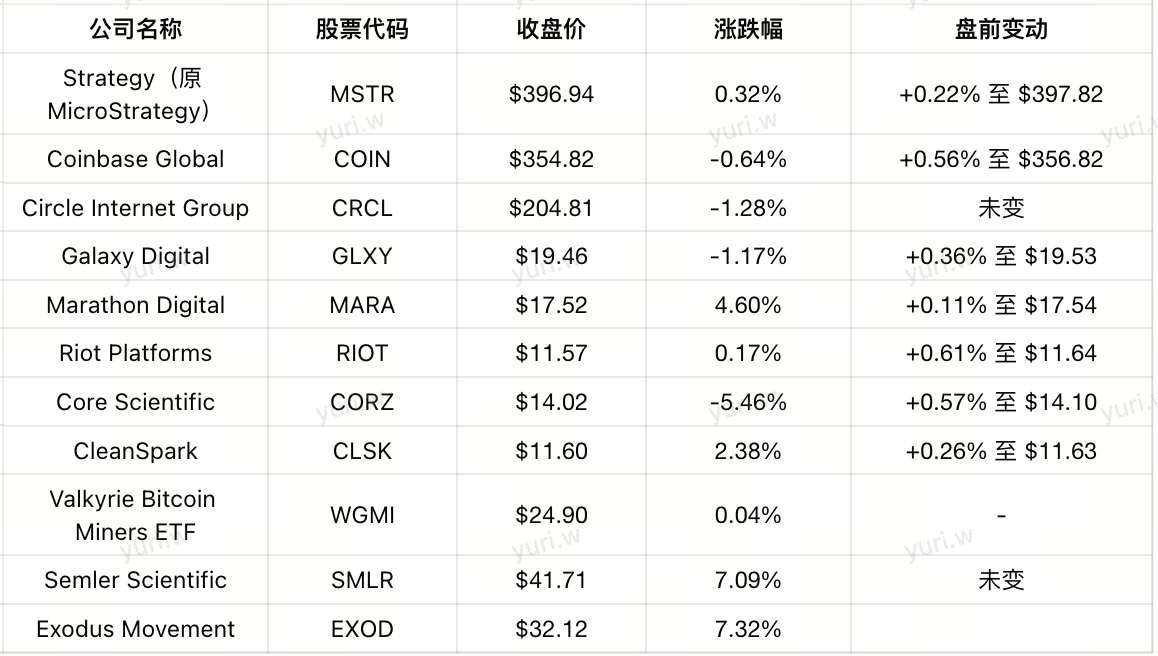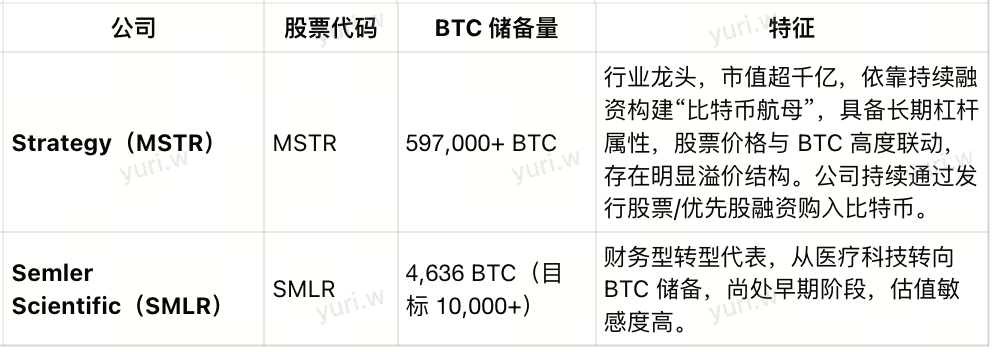Against the backdrop of the successful launch of the Bitcoin ETF, the gradual approval of the Ethereum ETF, and the countdown to stablecoin legislation, a group of companies highly related to the crypto industry are playing an increasingly important role in the capital market, with the institutionalization process accelerating the differentiation of related stocks. They cover multiple segments including trading platforms, mining, electricity, asset management, stablecoin issuance, and constitute a bridge asset pool between traditional finance and Web3.
I. Latest Stock Price Performance (as of July 9, 2025)

ETF Fund Flows (as of July 9)
BTC Spot ETF: Daily net inflow of $75.3M, cumulative inflow of $49.91B, holding approximately 1.25M BTC
ETH Spot ETF: Daily net inflow of $46.7M, cumulative inflow of $4.52B, holding approximately 4.21M ETH
II. Crypto Stock Sector Breakdown and Company Positioning
1. Bitcoin Asset Reserve Type: Adopting BTC as core asset strategy, enterprises incorporate it into their balance sheets for long-term holding

1.1 MicroStrategy (MSTR): Prototype of Bitcoin Enterprise Accumulator
MicroStrategy (now renamed Strategy) is the earliest and most representative Bitcoin enterprise reserve holder globally. Since 2020, under the leadership of Executive Chairman Michael Saylor, the company has gradually abandoned traditional cash reserves and massively transformed its balance sheet towards Bitcoin. As of July 2025, the company holds 597,325 Bitcoins, with an average purchase price of around $66,385, with total costs exceeding $33.1 billion. Its stock price is highly correlated with Bitcoin price, with a correlation of 0.95 after the Bitcoin spot ETF approval in 2024, viewed by the market as a "high-leverage BTC alternative".
Its Bitcoin purchasing funds primarily come from three channels: stock issuance (such as the latest $4.2 billion plan), convertible debt financing, and operational cash flow.
This BTC-centric strategy has transformed it from a BI software enterprise to a Bitcoin aircraft carrier in the capital market. However, this model also brings financial risks such as high leverage (debt/equity ratio of 24.44%), net loss (nearly $5.3 billion), and extreme sensitivity to Bitcoin price fluctuations. The company appears to be an enterprise analysis software supplier (AI-driven Strategy One platform) but has essentially evolved into a capital market carrier for Bitcoin allocation, with its held Bitcoin value far exceeding the software business itself.
In the future, the company will continue to focus on BTC accumulation while actively developing SaaS-based enterprise financial management tools (such as Strategy Mosaic™), hoping to soften its Bitcoin strategy through software and explore service revenue to mitigate single asset dependence.
After being upgraded from OTCQX to the NYSE American market in 2024, the company's market attention has increased, with stock prices rising 42.76% in early 2025. Exodus's mission is to "ignite the escape from traditional banking systems" by empowering users with complete control of their digital assets (private keys stored on user devices), driving widespread adoption of crypto and DeFi. The company supports over 100 cryptocurrencies (such as Bitcoin, Ethereum, Litecoin, etc.) and provides a seamless experience across multiple platforms (desktop, mobile, browser extension). In the future, Exodus will deepen DeFi integration, globally promote fiat exchange services (XO Pay), and enhance fiat-to-crypto capabilities through acquisitions (such as Banxa Holdings). Core challenges include market volatility, regulatory uncertainty, intensifying competition, and slowing user growth (Q1 MAU declined by 30%). 2.3 Coinbase (COIN) and Circle (CRCL): Fiat-Crypto Dual Pillars Coinbase (COIN) and Circle (CRCL) have built a bridge connecting traditional finance and digital assets through their dual-pillar model of fiat and cryptocurrency. Coinbase provides crypto trading and custody services, while Circle issues USDC stablecoin, driving fiat-to-crypto conversion and blockchain payments. Main Business: Coinbase focuses on crypto exchange, custody, and one-stop payment solutions; Circle concentrates on USDC issuance, payment networks, and blockchain infrastructure, being the world's second-largest dollar stablecoin. Coinbase promotes USDC, Circle provides reserve revenue sharing, forming a "fiat-crypto" closed loop. In 2024, USDC income accounted for 42% of Coinbase's non-trading revenue. USDC is Coinbase's second-largest revenue source, accounting for about 15% of Q1 2025 revenue, surpassing staking income. Financial Performance: In 2024, Coinbase's revenue was $9.185 billion, a 75% year-on-year increase; Circle's revenue was $1.68 billion, a 15.57% year-on-year growth. In Q1 2025, Coinbase's revenue grew by 72%, and Circle benefited from the IPO boom, with a market value of $60 billion. Coinbase Global (COIN) Market Cap Status: Successfully included in S&P 500 in 2025, marking institutional recognition of its liquidity. Holds 90% of US spot ETF custody shares, converting compliance costs into a competitive advantage through "regulatory arbitrage". Strategic Dynamics: Acquired derivatives leader Deribit for $2.9 billion, strengthening global options trading layout; custody assets exceed $400 billion. New Growth Points: ETH staking and Layer 2 solution income accounts for 35%; cross-border payment product "Coinbase Commerce" integrated with Shopify ecosystem; expanding USDC payment applications, enhancing DeFi ecosystem supported by Base network. Risk Points: Revenue dependent on trading activity, highly affected by market volatility; facing global compliance pressures and hacker risks. Pending SEC lawsuit; Trump's policy relaxation may weaken its compliance premium. Circle Internet Group (CRCL) Business Advantages: Asset-backed by US Treasury bonds and cash, strong compliance; high integration in partner networks like Visa and Solana. New Growth Points: Enterprise treasury management platform "Circle Business" newly integrated with PayPal and Stripe, targeting B2B cross-border settlement blue ocean; expanding cross-border payments and tokenized financial applications through CPN and USYC, applying for trust bank license. Policy Dividends: Stablecoin USDC recognized by the GENIUS Act, requiring 100% reserve assets, eliminating de-pegging risks. Potential Risks: Slowing growth, stablecoin market share eroded by new competitors, and high dependence on interest rate markets. These companies play the role of "water, electricity, and gas" in the crypto financial system, building underlying support structures from exchanges, payment stablecoins to wallets and institutional services. COIN and CRCL are platform cores, EXOD provides personal entry, and GLXY bridges traditional finance with new computing power markets, offering a portfolio configuration that balances stability and growth.







